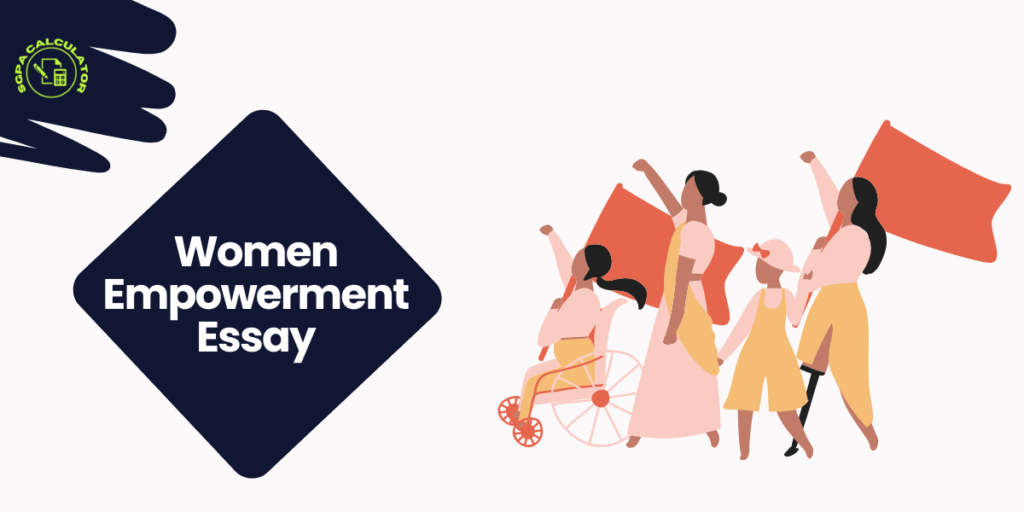Creating an environment where women may exercise their rights, access opportunities, and participate fully in all facets of life is the goal of a number of initiatives, strategies, and policies together referred to as “women empowerment essay,” which is a crucial and transformational notion. In addition to being an issue of social justice, women’s empowerment is a major force behind long-term prosperity, the economy, and societal advancement. In order to achieve gender equality, this essay examines the significance of women’s empowerment, as well as its advantages, difficulties, and key stakeholders.
The Importance of Women Empowerment Essay
Recognizing and upholding women’s rights to equality, respect, and self-determination is vital to empowering them. Women have consistently experienced structural exclusion, discrimination, and unequal access to opportunities and resources throughout history. But empowering women entails more than just righting historical wrongs; it also entails building a society in which women can actively engage in decision-making, contribute to economic growth, and play a critical role in determining the course of the future.
Read Our Essay: Cow Essay
Advantages of Empowering Women
Women’s empowerment has significant advantages for people on an individual, family, community, and societal level. Improving economic results is one of the main advantages. Women greatly contribute to economic progress when they have access to education, jobs, and entrepreneurial possibilities. Studies have repeatedly demonstrated that promoting gender equality in the workplace increases creativity and productivity.
Furthermore, improvements in health and education results are strongly correlated with women’s empowerment. Women who are educated and empowered are more likely to make decisions that are in the best interests of their own and their families’ health, which lowers the rates of maternal and infant mortality. In addition, women who have access to education can be helpful in ending the intergenerational cycle of poverty.
Obstacles to Women’s Equality
Despite the advancements of recent decades, there are still many obstacles in the way of women’s empowerment. Women’s advancement is still hampered by gender-based violence, unequal pay, restricted access to healthcare and education, and discriminatory laws. Traditional gender conventions and stereotypes also help to keep these problems alive.
The underrepresentation of women in leadership roles is a substantial barrier. Women are still underrepresented in leadership positions in politics, business, and academia, despite significant advancements. Policy choices are impacted by this lack of representation, which also feeds a cycle of male-dominated power systems.
Education’s Function
A key factor in women’s empowerment is education. Women who have access to high-quality education are better equipped with the information and abilities needed to effectively engage in society. It gives individuals the ability to question accepted beliefs, exercise critical thinking, and make wise decisions about their lives. Education can also boost women’s earning capacity and open up new economic opportunities, lessening their vulnerability to poverty.
The Function of Government and Policy
Through policy measures, governments play a critical role in advancing women’s empowerment. Critical steps include putting legislation into place to guarantee gender equality, protection against gender-based violence, and access to basic services. For instance, equal pay policies, accessible daycare options, and paid maternity leave can all help to boost women’s participation in the workforce.
The Function of Civil Society and Non-Governmental Organisations (NGOs)
NGOs and other civil society groups play a crucial role in promoting women’s rights and activities that support their empowerment. These groups operate locally to provide marginalised women with resources, education, and support. Additionally, they promote gender equality and try to alter society perceptions.
Empowerment in Various Fields
Women’s empowerment is multifaceted and encompasses a range of areas, including the political, social, cultural, and economic ones. Ensuring equal access to resources, credit, and employment opportunities is a key component of economic empowerment. The goal of political empowerment is to increase women’s involvement in all levels of decision-making. Social empowerment takes into account shifting cultural ideas and gender roles.
The Way Forward
Women’s empowerment and gender equality must be achieved over time, and this process calls for coordinated efforts from all facets of society. To fight and eliminate the mechanisms that uphold gender inequality, governments, civil society, corporations, and individuals must collaborate. This entails confronting societal norms and attitudes that support discrimination in addition to filling in policy gaps.
Campaigns for education and awareness are crucial parts of this journey. People can help create more inclusive and encouraging conditions in society by becoming more informed about the advantages of gender equality and women’s empowerment. By joining forces in the battle for gender equality, men and boys play an important part in this process as well.
Summary
The cornerstone of societal advancement and gender equality is women’s empowerment. Increased economic growth, better health and educational performance, and more inclusive decision-making are all benefits of empowered women. However, issues like discrimination, gender-based violence, and unequal representation continue to exist. Governments, NGOs, corporations, and individuals must work together to empower women. Societies may build a future that is more just and equitable for everyone by promoting a culture of gender equality and questioning ingrained practices.





